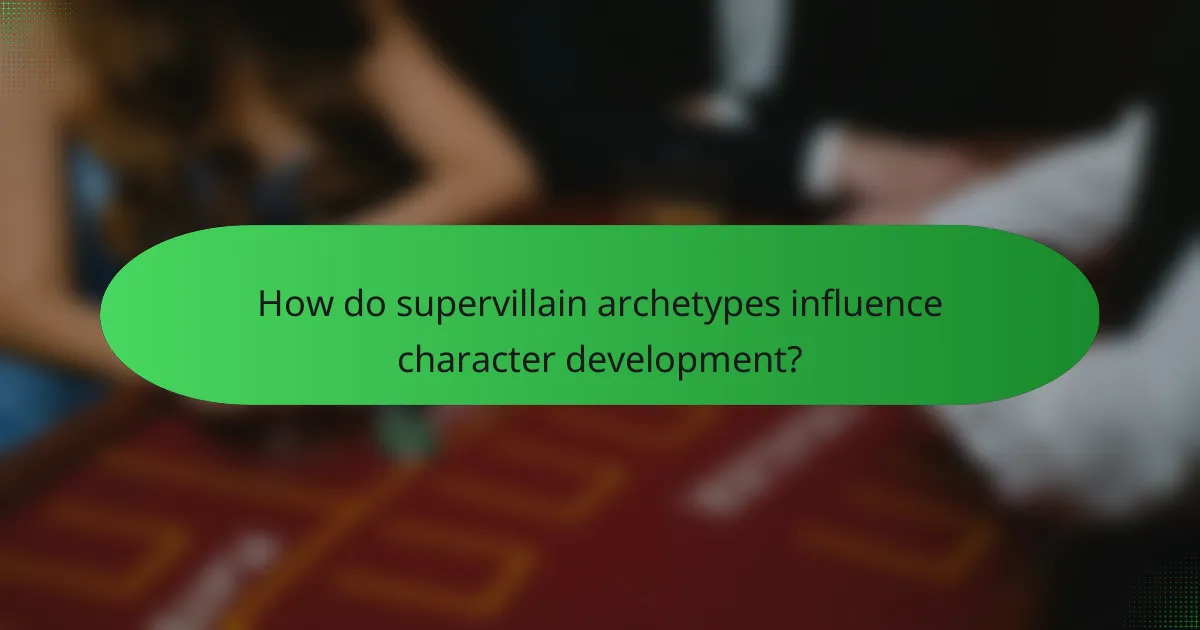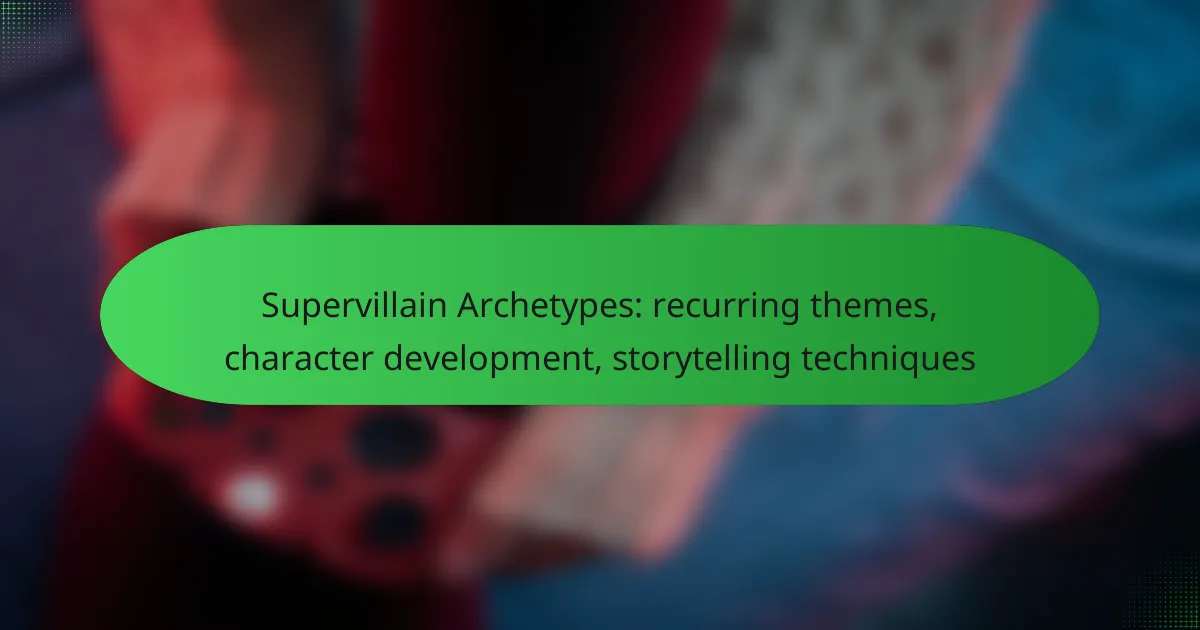Supervillain archetypes play a crucial role in storytelling by embodying specific traits and motivations that drive conflict and character development. These archetypes not only provide a framework for understanding villainous behavior but also allow writers to explore the complexities of morality and transformation within their narratives. By employing effective storytelling techniques, such as foreshadowing and symbolism, creators can craft memorable supervillains that resonate with audiences and enhance the overall depth of the story.

What are common supervillain archetypes in storytelling?
Common supervillain archetypes in storytelling include distinct character types that embody specific traits and motivations. These archetypes help to create engaging narratives by providing a framework for conflict and character development.
The Mastermind
The Mastermind is characterized by intelligence and strategic thinking, often orchestrating complex plans from behind the scenes. This archetype relies on manipulation and foresight, making them a formidable opponent for heroes.
Examples include characters like Lex Luthor or Ra’s al Ghul, who use their intellect to challenge heroes. Writers should focus on showcasing their cunning and ability to anticipate the hero’s moves, creating tension and suspense.
The Brute
The Brute archetype is defined by physical strength and aggression, often relying on sheer power to achieve their goals. This character typically embodies raw force, making them a direct threat to heroes.
Examples include characters like The Hulk’s nemesis, Abomination, or Bane from Batman. When developing a Brute, emphasize their imposing presence and the fear they instill, while also exploring any underlying motivations that drive their violence.
The Anti-Hero
The Anti-Hero straddles the line between villain and hero, often possessing morally ambiguous traits. This character may engage in villainous acts for a perceived greater good or personal gain, making them complex and relatable.
Examples include Deadpool and Venom, who often operate outside traditional moral boundaries. Writers should highlight their internal conflicts and motivations, allowing readers to empathize with their choices despite their questionable actions.
The Tragic Villain
The Tragic Villain is marked by a backstory filled with loss or trauma, leading them down a dark path. This archetype evokes sympathy, as their actions often stem from deep emotional pain or misguided intentions.
Examples include characters like Magneto or Green Goblin, whose personal histories inform their villainy. When crafting a Tragic Villain, focus on their past experiences and how these shape their current motivations, creating a layered character that resonates with the audience.
The Corrupt Politician
The Corrupt Politician archetype embodies the misuse of power for personal gain, often manipulating laws and systems to achieve their ends. This character represents societal issues, reflecting real-world concerns about corruption and ethics in leadership.
Examples include characters like Lex Luthor in his political role or Wilson Fisk (Kingpin). Writers should emphasize their cunning, charisma, and the impact of their corruption on society, creating a compelling antagonist that challenges the hero on multiple levels.

How do supervillain archetypes influence character development?
Supervillain archetypes significantly shape character development by providing a framework for their motivations, conflicts, and potential for transformation. These archetypes help writers create compelling narratives that explore the complexities of villainy and its impact on protagonists.
Motivation and Backstory
Understanding a supervillain’s motivation and backstory is crucial for character development. Common motivations include revenge, power, and ideology, which can stem from traumatic past experiences or societal rejection. For example, a villain driven by revenge may have lost a loved one to a hero’s actions, creating a personal vendetta that fuels their actions.
Backstories often reveal the vulnerabilities of supervillains, making them more relatable. A well-crafted backstory can evoke empathy, allowing audiences to understand the villain’s choices, even if they don’t condone them. This complexity adds depth to the character and enhances the overall narrative.
Conflict with Protagonists
Supervillains are essential for creating conflict with protagonists, serving as the primary obstacle that heroes must overcome. This conflict often highlights the moral dilemmas faced by both parties, forcing the hero to confront their own values. For instance, a villain who believes in a twisted form of justice may challenge the hero’s understanding of right and wrong.
The nature of the conflict can vary, ranging from physical confrontations to psychological battles. Writers should consider how the villain’s goals directly oppose the hero’s objectives, creating tension and driving the plot forward. This dynamic not only makes for engaging storytelling but also deepens character arcs.
Transformation and Redemption
Transformation and redemption arcs for supervillains can add layers to their character development. Many stories explore the potential for change, where a villain may seek redemption after realizing the consequences of their actions. This journey can resonate with audiences, illustrating themes of forgiveness and personal growth.
However, not all supervillains are redeemable, and the choice to transform should be meaningful. Writers should carefully consider the circumstances that lead to a villain’s change of heart, ensuring that it aligns with their established motivations and backstory. This balance can create a satisfying narrative that reflects the complexities of human nature.

What storytelling techniques enhance supervillain portrayals?
Effective storytelling techniques can significantly enhance the portrayal of supervillains, making them more compelling and memorable. Techniques such as foreshadowing, symbolism, and impactful dialogue contribute to deeper character development and richer narratives.
Foreshadowing
Foreshadowing is a powerful technique that hints at a supervillain’s future actions or their ultimate fate. By dropping subtle clues throughout the story, writers can create tension and anticipation, keeping the audience engaged. For instance, a villain’s seemingly innocuous comment about betrayal can foreshadow a dramatic twist later in the plot.
When using foreshadowing, ensure that the hints are not too obvious, as this can diminish the impact. Instead, aim for a balance where the clues are intriguing yet not immediately decipherable. This encourages viewers to re-evaluate earlier scenes upon revelation.
Symbolism and Themes
Symbolism enriches supervillain portrayals by linking their actions and motivations to broader themes. For example, a villain who embodies chaos might be associated with natural disasters, representing the unpredictability of their character. This connection can deepen the audience’s understanding of the villain’s psyche and objectives.
Incorporate themes such as power, revenge, or redemption to create a more nuanced villain. This approach allows for exploration of moral complexities, making the supervillain relatable despite their actions. Consider how the villain’s backstory can symbolize larger societal issues, enhancing the narrative’s depth.
Dialogue and Monologues
Dialogue and monologues are crucial for revealing a supervillain’s motivations and philosophies. A well-crafted monologue can provide insight into their worldview, making them more than just an antagonist. For instance, a villain might articulate their disdain for societal norms, showcasing their justification for their actions.
When writing dialogue, aim for a balance between dramatic flair and authenticity. Avoid clichés and strive for lines that resonate with the character’s unique voice. Additionally, consider how the villain interacts with other characters; their responses can reveal vulnerabilities or strengths that add layers to their persona.

How do cultural contexts shape supervillain archetypes?
Cultural contexts significantly influence supervillain archetypes by reflecting societal values, fears, and historical narratives. These archetypes evolve to resonate with local audiences, often embodying the unique challenges and ideologies of their respective cultures.
Regional Variations
Supervillain archetypes vary widely across different regions, often mirroring local myths, legends, and societal issues. For instance, in the United States, villains like Lex Luthor often represent corporate greed and the misuse of power, while in Japan, characters like Frieza from Dragon Ball may embody existential threats and the consequences of technological advancement.
In Europe, supervillains may draw on historical figures or folklore, such as the cunning of Loki in Norse mythology, showcasing a blend of cultural heritage and modern storytelling. These regional variations allow audiences to connect deeply with the narratives, as they reflect familiar societal dynamics.
Historical Influences
Historical events play a crucial role in shaping supervillain archetypes, as they often draw inspiration from real-world conflicts and crises. The Cold War, for example, influenced the portrayal of villains as embodiments of ideological extremism, such as the Red Skull in Marvel Comics, representing fascism and totalitarianism.
Moreover, the rise of global terrorism has led to the emergence of villains that reflect contemporary fears, such as those who exploit technology for nefarious purposes. Understanding these historical influences can enhance the depth of character development and storytelling techniques, making the villains more relatable and impactful.

What role do supervillains play in popular media?
Supervillains serve as central antagonists in popular media, driving conflict and character development. They often embody societal fears and challenges, making them essential for storytelling and audience engagement.
Film and Television Examples
In film and television, supervillains are crucial for creating tension and drama. Iconic characters like the Joker from “The Dark Knight” or Thanos from the Marvel Cinematic Universe illustrate how a well-developed antagonist can elevate a narrative. Their motivations often reflect deeper themes, such as revenge, power, or ideology.
Effective supervillains often have complex backstories that resonate with audiences, making them relatable despite their malevolent actions. This complexity can lead to memorable moments and discussions about morality and justice.
Comic Book Representations
Comic books frequently explore supervillains through elaborate story arcs and character development. Villains like Lex Luthor and Magneto showcase how personal experiences shape their villainy, often blurring the lines between good and evil. This depth allows readers to engage with their stories on multiple levels.
Comic book narratives often utilize recurring themes, such as redemption or the impact of trauma, which can make supervillains compelling. Their interactions with heroes often serve to highlight the hero’s virtues and flaws, enriching the overall storyline.
Video Game Antagonists
In video games, supervillains often serve as the primary obstacles players must overcome. Characters like GLaDOS from “Portal” or Sephiroth from “Final Fantasy” exemplify how antagonists can create immersive experiences through challenging gameplay and engaging narratives. Their motivations often drive the game’s plot, enhancing player investment.
Game developers frequently use supervillains to introduce moral dilemmas and choices that affect gameplay. This interactivity allows players to explore different outcomes based on their decisions, making the villain’s role even more significant in shaping the player’s journey.

How can writers effectively create unique supervillains?
Writers can create unique supervillains by blending archetypal traits with innovative motivations, ensuring depth and originality. This approach allows for complex character development that resonates with audiences while maintaining narrative coherence.
Combining Archetypes
Combining different supervillain archetypes can lead to more nuanced characters. For instance, merging the “Mastermind” with the “Rebel” can create a villain who not only plans meticulously but also challenges societal norms, making them more relatable and compelling.
Consider the balance between traits; too much focus on one archetype may render the character predictable. Aim for a blend that highlights strengths and weaknesses, allowing for dynamic interactions with heroes and other characters.
Innovative Motivations
Innovative motivations can set a supervillain apart from traditional archetypes. Instead of the common desire for power or revenge, consider motivations rooted in personal trauma, societal issues, or philosophical beliefs. For example, a villain driven by a desire to expose corruption can create moral ambiguity, prompting readers to question their own values.
When developing motivations, ensure they align with the character’s backstory and personality. This consistency will enhance believability and allow for richer storytelling. Avoid clichés and strive for originality to keep audiences engaged and invested in the character’s journey.
